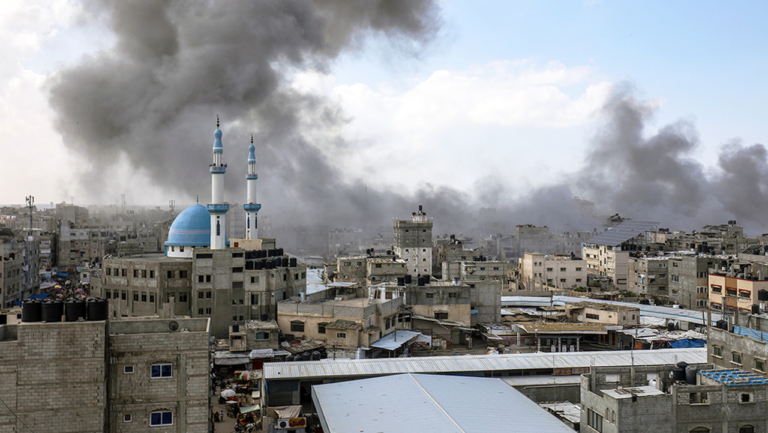
The October 7 Hamas attack on Israel and Israel’s subsequent invasion of the Gaza Strip will play a major role in shaping what unfolds in the Middle East in 2024. The Gaza war has manifestly and tragically affected Palestinians in Gaza and the occupied West Bank; so far, tens of thousands have been killed or injured and millions have been displaced. The war is also likely to have serious repercussions for neighboring countries, and indeed for the entire region, in 2024. And the war will continue to damage the reputation of the United States and western powers that by and large have stood by Israel in Gaza as it has violated the laws of war, international humanitarian law, and other international rules and norms.
Beyond Gaza, the Middle East continues to suffer from other problems that will have their own repercussions in 2024. From Syria’s authoritarian rule to Sudan’s war between its military elites, to Libya’s absence of a unifying political agreement, to Yemen’s search for a final accord to end its conflict, the region awaits an elusive peace and certainty. In the meantime, authoritarianism reigns supreme in the region, and many countries continue to experience economic crisis, social dislocation, and environmental degradation. To be sure, if no effective solutions are devised for the myriad of troubles expected in the Middle East in 2024, the year may move the region closer to a social and political explosion that has detrimental effects on the entire world.
To address important issues at hand in this vital region, Arab Center Washington DC (ACW) has asked some of its fellows and affiliates to offer reasoned perspectives about what they expect in 2024, including what may happen in US relations with the region. Issues not addressed here will undoubtedly be covered on our pages throughout the year by these and other experts.
Table of Contents:
- Deadly Conditions Await Internally Displaced People in Gaza in 2024
- Autocratic Resilience in the Middle East
- A Resurgence of Non-State Actors of the “Axis of Resistance”
- US Palestine Policy in 2024: More Challenges and Broken Promises
- The Western Media Must Assume Its Journalistic Duties in 2024
- Biden Administration Policy Will Worsen Conditions in the Middle East
- Biden’s Gaza Stand Does Not Bode Well for His Re-Election
- Expect More Repressive Measures Against Palestine Activism in the United States
Deadly Conditions Await Internally Displaced People in Gaza in 2024
Yara M. Asi, ACW Non-resident Senior Fellow
Among the many inconceivable statistics that have been reported from the occupied and besieged Gaza Strip since the beginning of the current Israeli military campaign have been those tracing the unprecedented levels of displacement. Of the 2.2 million residents of the Gaza Strip today—80 percent of whom are already registered refugees from 1948 and their descendants—it is estimated that at least 85 percent had been displaced from their homes by the end of 2023.
Footage of Gaza shows utter destruction: entire neighborhood blocks have been ruined, including schools, shops, health facilities, and homes. Many of the Gazans forced to flee their homes since October 7 will have nothing to return to—if they are able to avoid being killed by bombing, infection, or starvation. There is no easy road ahead for these nearly 2 million people, even if the bombs were to stop tomorrow—and there is no indication that will happen any time soon.
Reports from survivors and from aid workers on the ground paint a harrowing picture of the few shelters that remain functional, with significant overcrowding and a lack of water, food, fuel, medical care, and sanitation facilities. Most residents of Gaza are experiencing starvation, with many reporting that they are barely able to eat one meal per day. Pregnant women are forced to give birth in crowded and unsanitary conditions, sometimes without access to pain medication or even to a medical professional. These horrific conditions, coupled with the collapse of the health system in Gaza and the weakened physical state of survivors, create a perfect setting for the spread of infectious diseases, which some experts predict could kill many more people than airstrikes in the coming months.
Massive tent cities have formed throughout the south of the Strip, with extended families huddled into small, sometimes makeshift structures. Some Gazans only have managed to make the most basic of shelters from salvaged wood and rubble, leaving them completely exposed to rain and unbearably cold temperatures. How will these families fare in the coming months? Aside from countless challenges to their mere survival, larger questions persist. Where will these people go? Who will pay to rebuild the ruins of their homes and neighborhoods? Will they even be able to call Gaza home again?
Leaders from many humanitarian agencies—who in recent years have witnessed atrocities in Afghanistan, Myanmar, Syria, Ukraine, and Yemen, among other sites of mass violence and deprivation—report that the humanitarian conditions in Gaza today are among the worst they have ever seen develop so rapidly. Simply to help Gazans achieve a minimally acceptable standard of living, aid organizations are requesting significant investments that have never been fully met by donors. The level of death and destruction is dire, but the conditions for those left living in Gaza are horrific, including for hundreds of thousands of children. That such conditions could be justified by the world’s most powerful countries is an indictment of the credibility of the so-called international community, which has continuously made clear that some lives are more worthy of protection than others.
Autocratic Resilience in the Middle East
Daniel Brumberg, ACW Non-resident Senior Fellow
While democratic backsliding has unfolded in many corners of the globe, including the United States, the Middle East is distinguished by the endurance of autocracies. Tunisia, the only Arab country that experienced a post-Arab Spring transition to an imperfect democracy, now is ruled by a populist autocrat who has consolidated his power. President Kais Saied has been embraced by many regional leaders such as Egypt’s President Abdel Fattah el-Sisi, whose regime has been busy offering Tunisia lessons in the technology of repression.
If regional support is a key factor in authoritarian resilience, it is not Egypt but rather the Gulf states that have emerged as the hub of authoritarianism in the region. Beyond oil rents, they have used regional and global dynamics to strengthen their regimes. Russia, China, and Iran also have played a crucial part in this story, but the preeminent ally of Arab autocracies is the United States. The dominant view in Washington is that Arab autocracies are more reliable US partners than democratizing governments are. Beyond hiring powerful Washington-based lobby firms to “sell” their image, Gulf Arab leaders surely have been relieved that the Biden White House endorsed the Abraham Accords in ways that strengthened regional strong men (including Israeli Prime Minister Benjamin Netanyahu).
But while such regional and global dynamics matter, in most cases the endurance of autocracy is a function of domestic politics. Apart from relying on powerful security systems, authoritarian rulers continue to exploit ideological, social, and identity fissures, thus recasting the “ruling bargain” between regimes and their willing domestic allies. Divided oppositions, weak political parties, and state-captured civil society organizations facilitate this divide-and-rule strategy, as does the exhaustion of everyday citizens struggling to survive.
That said, autocracies remain vulnerable. The Gaza war has exposed the enormous gap between many of the region’s regimes and societies on Palestine, while exploding the infrastructure of Israeli-Arab cooperation that had almost erased the Palestinians from the global political and strategic map. Moreover, rulers’ growing power—abetted by their use of technology to pursue critics at home and abroad—has left regimes dangerously isolated from many of their citizens, and made it harder to play the divide-and-rule game. Because this game requires a hobbled pluralism, it is possible that in 2024 some Arab leaders might try to foster a measure of political infitah, or opening, as long as they can limit such reforms from upending their rule.
A Resurgence of Non-State Actors of the “Axis of Resistance”
Imad K. Harb, ACW Director of Research and Analysis
The last quarter of 2023 provided a clear indication that Iran’s non-state affiliates in the Arab world—Lebanon’s Hezbollah, Palestine’s Hamas, Yemen’s Houthis, and Iraq’s Shia militias—are likely to see a resurgence in 2024. Prior to and during 2023, these groups had succeeded in carving for themselves dominant roles, indeed dominant domains, in the countries where they operate, although they remained unrecognized by the international community as legitimate rulers or political actors. Hezbollah has for years exercised effective influence over Lebanese affairs; prior to October 7 Hamas had full control over the Gaza Strip; the Houthis appointed themselves rulers in Sanaa in 2014; and over the past decade Iraq’s many Shia militias have coalesced to control the country’s decision-making.
Following Hamas’s fateful attack on southern Israel on October 7, all four Iran-aligned actors have participated in one way or another in a regional challenge to Israel’s indiscriminate war against the Palestinians and its assumed military superiority. Hezbollah in particular has since October 7 engaged in violent and mutually painful skirmishes with Israeli forces that killed civilians and military personnel on both sides and caused the evacuation of tens of thousands of Israelis and Lebanese citizens from villages and towns along the border. The Houthis also launched missiles on allegedly Israeli-linked shipping targets, tried to halt maritime traffic destined for Israel, and indeed threatened the freedom of navigation in the vital Red Sea and Bab al-Mandeb waterway. Iraq’s militias also put United States military forces on the defensive in Syria and Iraq and are now exercising extreme pressure on the Iraqi government to end the American military presence in the country, a goal long coveted by Iran.
This high degree of activism in challenging Israeli and American policies has so far been met by both utter hubris and refusal to acknowledge realities in Tel Aviv and Washington. Israel continues to pursue a colonial-settler agenda regarding Palestinian rights and to prosecute a genocide in Palestine that has since October 7 killed some 23,000 people in Gaza and some 330 in the occupied West Bank, injured about 60,000, displaced close to two million people, and destroyed hundreds of thousands of homes. The underlying logic is based on the long-used premise of “might is right,” as the United States maintains its blind diplomatic and military support of Israel despite the obvious cost to the United States’ reputation. In pursuing a military solution in Gaza—although it is obvious that there is no such solution to the Palestine question—Israel and the United States ignore the reality that the Palestinians are a people with rights and that they are not going to accept living as second-class citizens in an apartheid state.
Iran’s non-state affiliates in the Arab world do not have a monopoly on the struggle against Israel’s policies and practices and the United States’ complicity in the latter’s war on the Palestinians. But in the near-absence of a serious Palestinian alternative to Hamas in the conflict with Israel, and the utter failure of the Arab world to stand up to Israel and the United States, the Islamic Republic’s Arab friends seem to be the only actors willing to defend Palestinian rights, whatever the cost. In an environment of Palestinian and Arab officialdom bereft of an effective response to Israel’s denial of rights and indeed genocide, the non-state actors of the “axis of resistance” are likely to achieve more prominence and strength in 2024.
US Palestine Policy in 2024: More Challenges and Broken Promises
Khalil E. Jahshan, ACW Executive Director
As the United States embarks on resuscitating its Middle East diplomatic campaign for the new year, and amid fears in Washington about regional escalation beyond Gaza, the Biden administration dispatched this week top officials in a regional tour de force. In addition to Secretary of State Antony Blinken, those traveling this week include Assistant Secretary of State for Near Eastern Affairs Barbara Leaf, Department of State Counselor Derek Chollet, Assistant Secretary of State for Energy Resources Geoffrey Pyatt, and the White House Special Presidential Energy Security Coordinator Amos Hochstein. Blinken’s week-long trip, which covers nine countries, is his fourth to the region since October 7.
On the eve of his departure for the Middle East, Secretary Blinken stated that his mission focuses primarily on preventing the Gaza war from escalating into strategic regional trouble spots like Lebanon, Syria, Yemen, Iraq, Iran, and the Red Sea. The American diplomatic team also will concentrate on securing the release of Israeli hostages in Gaza, addressing desperate humanitarian needs in Gaza, and coordinating efforts with key stakeholders in the region about the “day after,” that is, who will reconstruct and rule Gaza post-Hamas.
The declared objectives of Blinken’s trip, as well as US policy in general, seem quite lofty and idealistic considering the excessive and unrelenting display by Israel of brutality, destruction, violence, and lust for vengeance since October 7, 2023. Furthermore, the goals set by the secretary reflect the one-sided position adopted by the Biden administration since the Hamas attack on that day. This position is part and parcel of familiar spent policies espoused by Washington over the past 75 years of protracted conflict in this turbulent region. President Biden proceeded on October 7 to accept Netanyahu’s logic and agenda for the war as if the history of the Arab-Israeli conflict began on that date, a policy approach that is totally divorced from 56 years of occupation and siege and 75 years of conflict.
In taking this stance, Biden has weakened the American position and undermined the credibility of the United States throughout the region. An overwhelming majority of Arab citizens across 16 countries in the Middle East and North Africa, polled during the last three weeks by the Arab Opinion Index at the Doha Institute in Doha, Qatar, questioned US policy and considered it lacking in credibility and effectiveness. Ninety-four percent looked at the United States position negatively. In addition, fifty-one percent saw the US as the biggest threat to the security and stability of the region, even ahead of Israel, Iran, China, and Russia. This deeply felt lack of credibility will remain the main challenge faced by the United States in the region throughout 2024, and well beyond.
The credibility deficit will deepen once the administration gets to the next phase of the raging conflict in Gaza. As Blinken continues US efforts to help release the hostages, he is faced with the complications created by his government’s one-sided policy. The same problem will emerge as US policy matures enough to seek a lasting and enforceable ceasefire between Israel and whatever government exists in Gaza at the time. American bona fides will prove too weak to carry the day. That weakness will particularly haunt the Biden administration, or its successor, once the parties get to the serious diplomatic challenge of forging a long-term, peaceful solution to the Palestinian-Israeli conflict.
The Western Media Must Assume Its Journalistic Duties in 2024
Tamara Kharroub, ACW Deputy Executive Director and Senior Fellow
Anti-Palestinian bias in western media has been well-documented for decades. The skewed coverage of Palestine and Israel in favor of the Israeli narrative is evident through the disproportionate use of Israeli sources as opposed to Palestinian ones, the dehumanization of Palestinians and double standards in coverage, and the decontextualization of events and the use of framings that rarely mention decades of Israeli occupation and oppression. Western coverage also frequently utilizes language that absolves Israel of committing crimes against Palestinians, for example by saying “Palestinians died” or “humanitarian crisis” without saying who is responsible and using emotive terminology like “horrific” only when reporting on incidents of Israeli deaths. This gross imbalance in reporting has persisted even though the overwhelming majority of victims in the conflict are Palestinians and there is abundant daily documentation of Israel’s violations of human rights and international law.
Decades of biased coverage have helped bring us to this moment of normalized anti-Palestinian racism, dehumanization, and unchecked genocidal language against Palestinians. The past three months of Israel’s war on Gaza have further exposed the western media’s misuse of journalistic ethics and standards and disregard for Palestinian lives. Recent quantitative studies of US cable news and print news coverage after October 7 confirm this bias.
At this pivotal moment in the Palestinian-Israeli conflict, information is power and is critical for decision-makers and the general public alike. The news media play a crucial role in shaping perceptions and influencing public opinion, and thus in garnering support for certain policies and actions, and even in manufacturing narratives and inciting hatred and violence. This is precisely why the media has traditionally been referred to as “the fourth estate” and why media outlets have journalistic standards and codes of ethics that they are expected to follow.
Dehumanization is the first step toward genocide, and the Western media’s blatant dehumanization of Palestinians and presentation of Israeli talking points as facts are alarming. Repeating the talking points of an occupying power known for violating international law and for persistently propagating false information, without questioning or scrutiny, fails the basic test of journalistic standards. But in the last three months most western journalists have largely failed to investigate, verify, or push back against Israeli government narratives and propaganda, while perpetuating the normalization of anti-Palestinian racism and dehumanization. This makes these journalists complicit in Israel’s crimes against Palestinians.
In this context of mainstream media bias, social media platforms have emerged as alternative spaces for marginalized and oppressed populations such as the Palestinians to tell their stories and to have agency over their narrative. With western media reporters absent in Gaza, it has been Palestinian journalists and content creators in the Strip who have risked their lives and those of their families to make sure the Palestinian reality and perspective are presented to the world. Shockingly, Israel has killed least 72 Palestinian journalists and media workers in Gaza since October 7, according to the US-based Committee to Protect Journalists (Palestinian sources put the number at more than 100). But social media companies, especially X and Meta’s Facebook and Instagram, also have contributed to the bias through censoring voices in support of Palestinians and removing and “shadow banning,” or limiting the visibility of, Palestinian content and accounts. This further contributes to limiting accountability efforts for Israeli crimes and to bolstering the dehumanization of Palestinians.
Today, as Israel’s genocide against the Palestinians in Gaza continues, the mainstream media and social media companies continue to practice double standards with regard to Palestinian lives, narratives, and voices, with some journalists even going as far as serving as apologists and defenders of well documented Israeli crimes. Whether this latest war on Gaza (and the killing so far of more 23,000 Palestinians, most of whom are innocent men, women, and children), will awaken the mainstream media and technology companies in 2024 remains to be seen. But what is clear is that in the digital media landscape there are limits to attempts at silencing oppressed groups and to control the narrative.
Biden Administration Policy Will Worsen Conditions in the Middle East
Laurie King, ACW Board Member
As the Biden administration begins what may well be its final year, US foreign policy in the Middle East is at last front and center, but not thanks to any resurgence of activity and concern at the White House or the State Department. Hamas’s unprecedented October 7 attack on southern Israel and Israel’s brutal response have rearranged many pieces on the regional chess board. Rather than steeling the United States to deal with changing dynamics, however, October’s aftermath has seen President Joe Biden and Secretary of State Antony Blinken stumbling blindly. They have lost political capital at home and abroad and continue to ignore the diverse tensions within and needs of countries such as Egypt, Jordan, and Iraq as the United States frantically sends military, financial, and diplomatic support to Israel’s Prime Minister Benjamin Netanyahu and his extreme right-wing government.
The Middle East did not loom large in Biden’s 2020 campaign platform; instead, China took center stage. Biden’s promise to remove the United States from the 20-year Afghanistan quagmire earned him his first sharp criticisms from both the left and right among US foreign policy pundits. While during the 2020 campaign Biden looked down his nose at Egyptian President Abdel Fattah el-Sisi as “Trump’s favorite dictator,” and expressed disgust with Saudi Arabia’s Crown Prince Mohammad bin Salman, once in office Biden eventually embraced both autocrats. As President, Biden has said little about human rights and democracy in the region, and rather than starting a new foreign policy chapter in the Middle East, has focused on trying to expand Trump’s Abraham Accords to Saudi Arabia and other Arab countries. Biden also ignored rising Israeli repression in the occupied West Bank and Gaza, turned a cold shoulder to Lebanon’s multiple crises, and showed little concern for or awareness of Iraq’s governance challenges.
No power in the world, other than the United States, can rein in Israel’s murderous actions in Gaza. If not checked, Netanyahu under American eyes may in 2024 push Gazans into Egypt and effectively destroy Israel’s peace agreements with both Egypt and Jordan. Such dire developments would ignite protests across the region, consign the Abraham Accords to history’s trash bin, and open the way for China to assume the mantle of global power player in the region.
Biden’s Gaza Stand Does Not Bode Well for His Re-Election
Dana El Kurd, ACW Non-resident Senior Fellow
Between October 7 and the end of November 2023, over 1,800 pro-Palestine protests took place in some 450 American cities across 49 states, the District of Columbia, Guam, and Puerto Rico. That number surely increased during the month of December. These protests cannot be explained simply by the concentration of Arab and Muslim Americans in certain states. Rather, they reflect the shift in US public opinion toward more pro-Palestinian views and many Americans’ reaction to the images and information coming out of Gaza.
The rise of pro-Palestine sentiment in the United States is a result of three main trends. First, despite the mainstream media narrative around Israel-Palestine, Americans today receive information from a broad array of sources. Young people in particular are utilizing social media far more than traditional media sources. Young Gazan journalists, such as Motaz Azaiza, Plestia Alaqad, and Bisan Owda, have amassed huge social media followings since October 7 with their persistent updates as they flee Israeli bombardment, and their content is widely shared among young users. TikTok even had to clarify, following criticism, that the proliferation of pro-Palestine content on its platform was not an intentional policy of the company, but rather reflective of how the majority of the app’s users felt about the subject.
Second, young people—particularly young Democrats—differ from older generations even within their own party on issues related to Israel-Palestine. Many Americans also connect what is happening with Palestine to issues closer to home, including movements like Black Lives Matter. This explains why there are so many protests in the United States and why a plurality of Americans disapprove of the Biden administration’s response to Israel’s war. A third trend is that Palestinian, Arab, Muslim, and progressive Jewish organizations have become increasingly active. Groups such as US Campaign for Palestinian Rights, the Palestinian Youth Movement, Jewish Voice for Peace, If Not Now, and similar groups have played a crucial role in mobilizing protests since October 7.
Such trends should be a warning sign to the Biden administration as President Biden enters a tough reelection campaign in 2024. In October 2023, Biden was already performing worse than Trump in key swing states (incidentally, where Arab and Muslim voters are also concentrated). Additionally, research shows that for Muslim and Arab US citizens specifically, foreign policy is quite important and helps to determine their vote. The Biden administration’s conduct during the Gaza war risks dampening voter turnout, especially among young voters on whom the Biden campaign relied in 2020. All of this bodes poorly for the president and for the Democratic Party’s chances in November, as well as for their legacy.
Expect More Repressive Measures Against Palestine Activism in the United States
Yousef Munayyer, ACW Director of Palestine/Israel Program and Senior Fellow
Support for Israel in the United States has been decreasing for years. After decades of fairly stable bipartisan support, growing cracks emerged in the last 15 years, and partisanship has increasingly defined the divide in American public opinion on this issue. The Israeli government and its allies have understood the challenge and have sought to try to stop the shift toward pro-Palestinian sentiment. The response to the events of October 7 showed that the challenge facing Israel’s supporters was far greater than they had previously understood.
Despite the unprecedented nature of the Hamas assault on Israel on October 7 and the public framing of it for American audiences as “Israel’s 9/11,” the same constituencies that had been alienated by Israel in the United States demonstrated solidarity with Palestinians as soon as Israeli bombs began dropping on Gaza. Despite the violence of October 7, supporters of Israel in the United States likely were taken aback by how little sympathy the moment generated for Israel, a development that exposed the scale of the challenge to Israel’s reputation in key US demographics.
Prior to October 7, a key strategy deployed by the Israeli government and its supporters was to repress activists and dissenters in the United States by pushing for laws to ban activism and criminalize or otherwise punish speech. Lawfare, a strategy in which activists or organizations are sued or are threatened with legal action, legislation such as anti-Boycott, Divestment, and Sanctions (BDS) laws, the legal redefinition of anti-Semitism to include Palestine-related speech, and smear campaigns have all been central to this strategy. After public opinion following October 7 showed greater global solidarity with Palestinians, the repressive effort went into overdrive.
Furthermore, as Israel’s military campaign in Gaza has led to charges of genocide and crimes against humanity global civil society efforts to hold Israel to account for human rights violations is likely to be energized in 2024 in previously unimaginable ways. This is likely to catalyze a repressive response from Israel and its supporters. With presidential elections in the United States taking place in 2024, US officials may feel compelled to support greater repressive action against pro-Palestine activism to avoid risking the support of key interest communities and donors.
featured image credit: Shutterstock/Anas Mohammad








